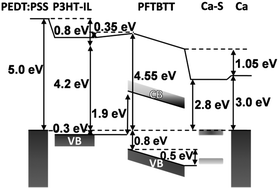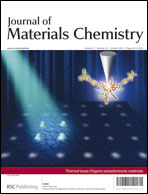We correlate the morphology and energy level alignment of bilayer structures comprising the donor poly(3-hexylthiophene) (P3HT) and the acceptor polyfluorene copolymer poly(9,9′dialklylfluorene-alt-4,7-bis(2,5-thiendiyl)-2,1,3-benzothiadiazole) (PFTBTT) with the performance of these bilayers in organic photovoltaic cells (OPVCs). The conducting polymer poly(ethylenedioxythiophene):poly(styrenesulfonate) (PEDT:PSS) was used as the bottom electrode and Ca as the top electrode. Ultraviolet photoelectron spectroscopy (UPS) revealed that notable interface dipoles occur at all interfaces across the OPVC structure, highlighting that vacuum level alignment cannot reliably be used to estimate the electronic properties for device design. Particularly the effective electrode work function values (after contact formation with the conjugated polymers) differ significantly from those of the pristine electrode materials. Chemical reactions between PEDT:PSS and P3HT on the one hand and Ca and PFTBTT on the other hand are identified as cause for the measured interface dipoles. The vacuum level shift between P3HT and PFTBTT is related to mutual energy level pinning at gap states. Annealing induced morphological changes at the P3HT/PFTBTT interface increased the efficiency of OPVCs, while the electronic structure was not affected by thermal treatment.

You have access to this article
 Please wait while we load your content...
Something went wrong. Try again?
Please wait while we load your content...
Something went wrong. Try again?


 Please wait while we load your content...
Please wait while we load your content...